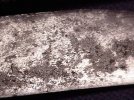not2sharp
Platinum Member
- Joined
- Jun 29, 1999
- Messages
- 20,449
This well aged little knife is interesting in a number of ways. For one thing it is mounted in tiger tooth and perhaps it is a very, very, small Dah with a very oddly shaped blade. The blade almost looks like a Pia-Kaetta although it is probably too light (thin - max is just over 1/8") to be one of those, and the furniture certainly does not look like what we usually find on a Pia.
We can see all of that in this photo:

But, what really had me cleaning my glasses was the surface of the blade. The texure has an odd optical effect that makes it look as though portions of the blade are covered in clear crystal. In the picture below you can see areas that show what looks to be significant pitting, but thrust me it is not really there. There is some very light pitting but the surface is actually smooth to the touch.
I tried different lighting and even magnification but the effect was still there. So I did what I seldom do and call the wife over to take a look at it. Fortunately, she agreed that the surface effect was really there; which was kind of a relief.
Has anyone seen something like this before? (someone suggested that this might be meteorite steel?)
n2s
We can see all of that in this photo:
But, what really had me cleaning my glasses was the surface of the blade. The texure has an odd optical effect that makes it look as though portions of the blade are covered in clear crystal. In the picture below you can see areas that show what looks to be significant pitting, but thrust me it is not really there. There is some very light pitting but the surface is actually smooth to the touch.
I tried different lighting and even magnification but the effect was still there. So I did what I seldom do and call the wife over to take a look at it. Fortunately, she agreed that the surface effect was really there; which was kind of a relief.
Has anyone seen something like this before? (someone suggested that this might be meteorite steel?)
n2s

